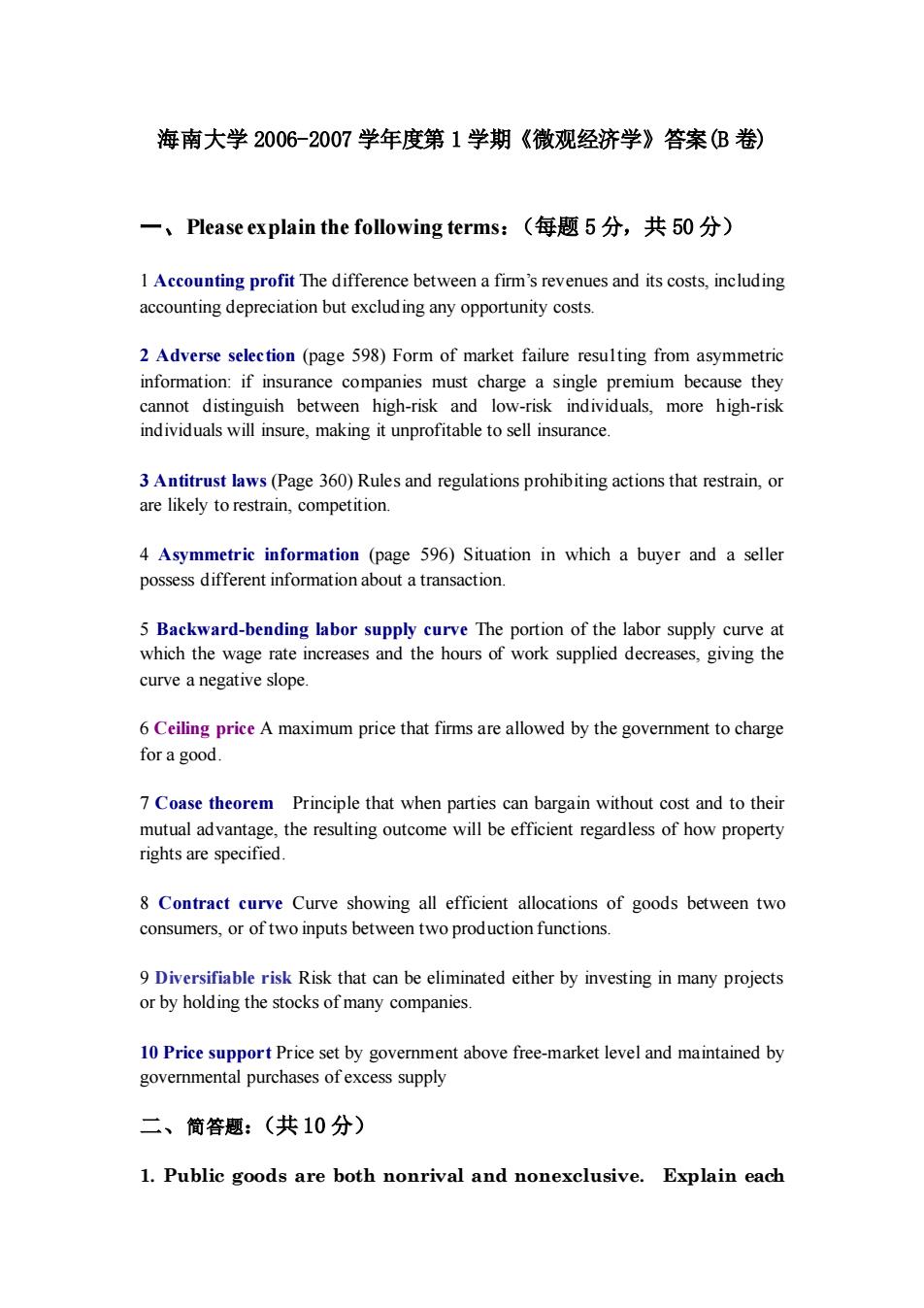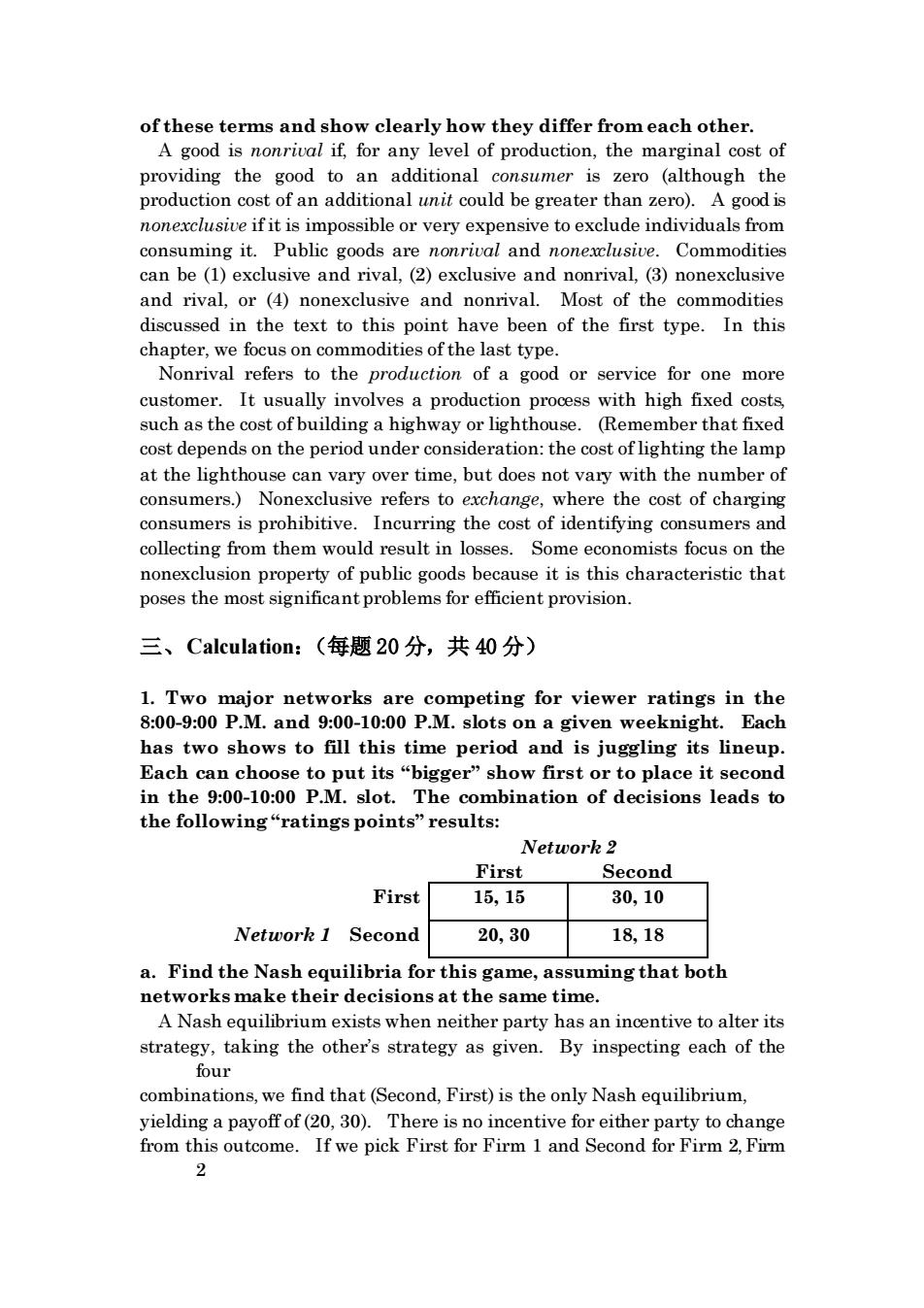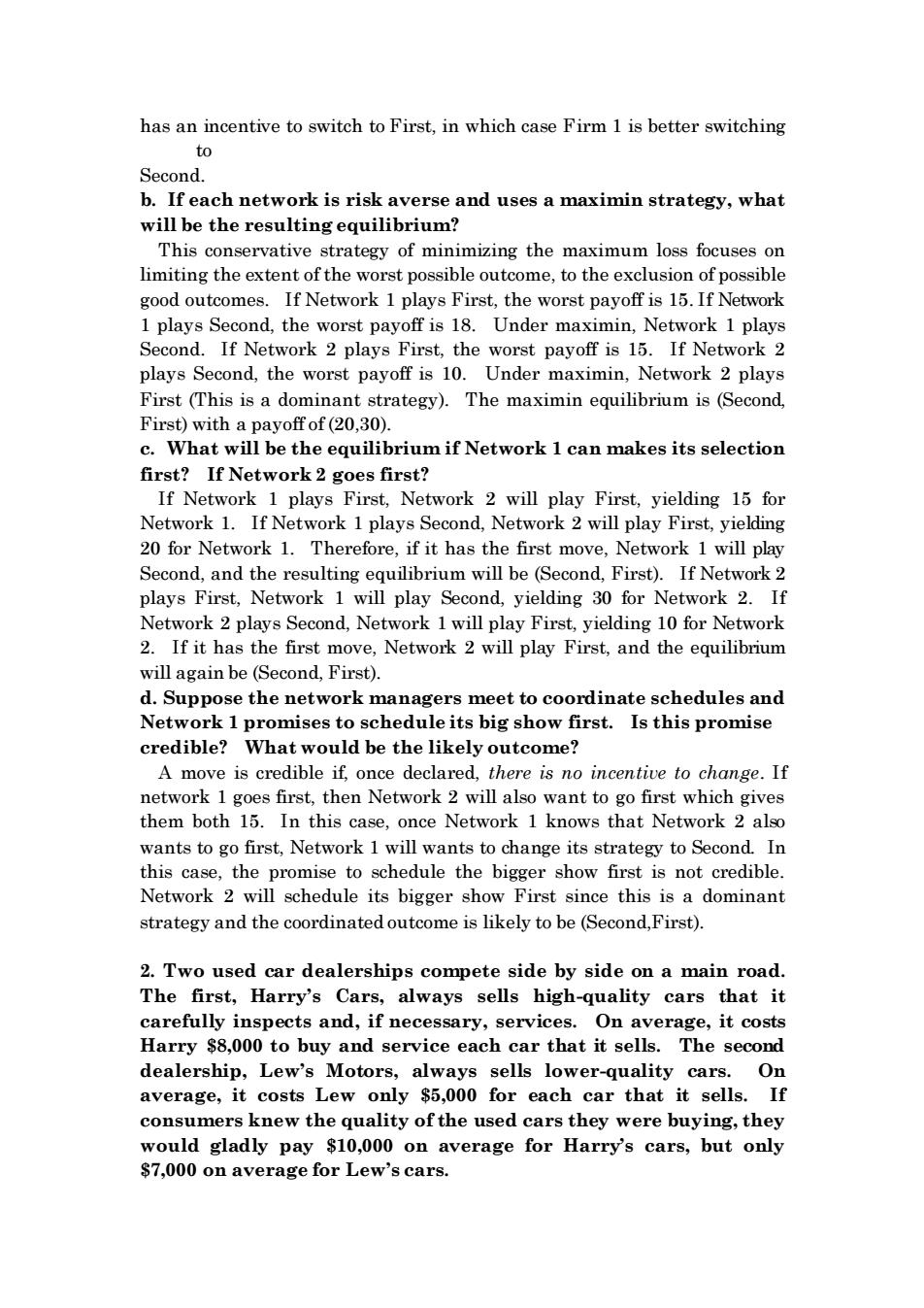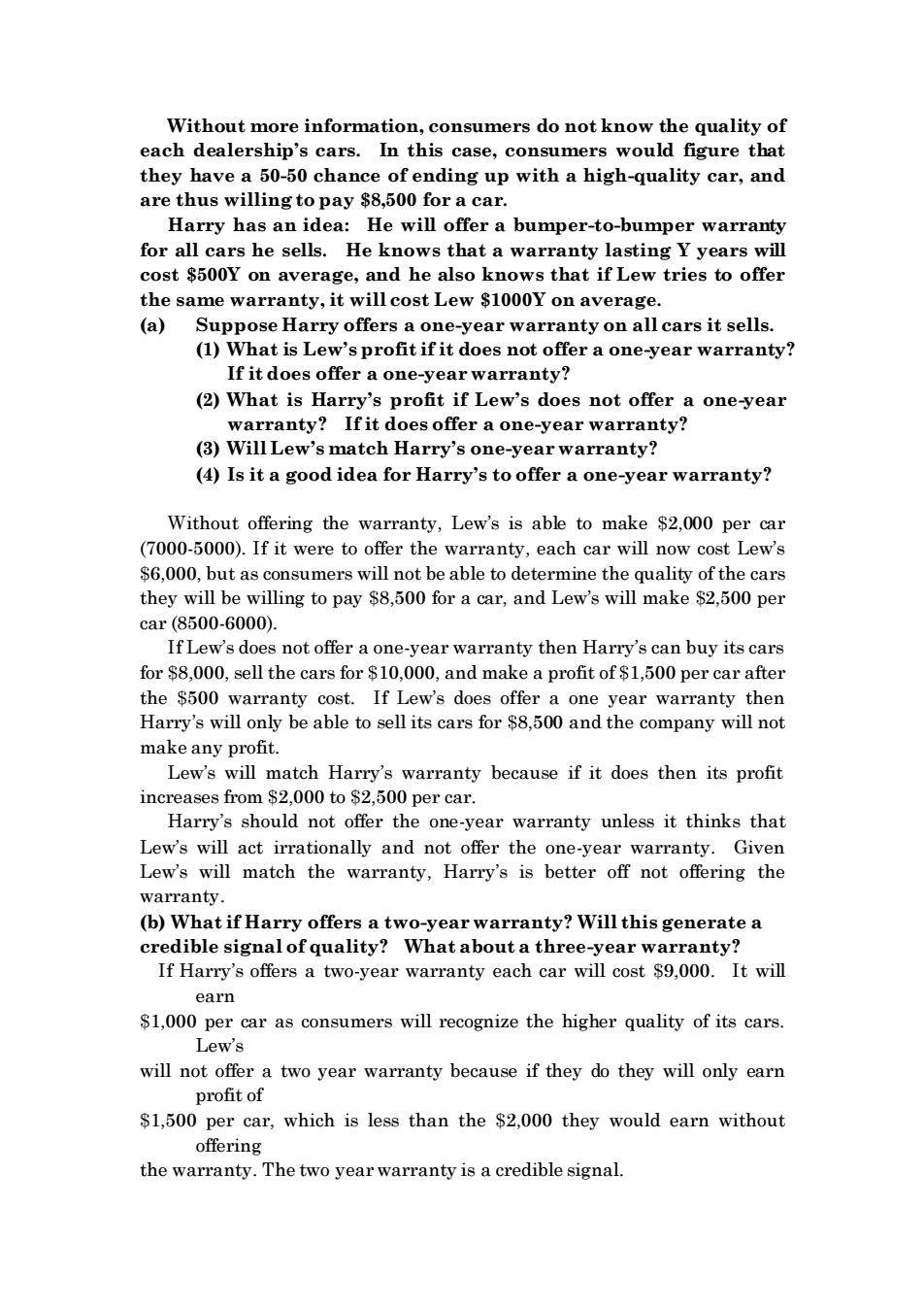
海南大学2006-2007学年度第1学期《微观经济学》答案(B卷) 一、Please ex plain the following terms:(每题5分,共50分) 1 Accounting profit The difference between a firm's revenues and its costs,including accounting depreciation but excluding any opportunity costs. 2 Adverse selection (page 598)Form of market failure resulting from asymmetric dnnn ca distinguish betwee n high-risk d low 3Antitrust laws(Page 360)Rules and regulations prohibiting actions that restrain,or are likely to restrain,competition 4 Asymmetric information (page 596)Situation in which a buyer and a seller possess different information about a transaction. 5 Backward-bending labor supply curve The portion of the labor supply curve at which the wage rate increases and the hours of work supplied decreases,giving the curve a negative slope 6Ceiling price A maximum price that firms are allowed by the government to charge for a good. 7Coase theorem Principle that when parties can bargain without cost and to their mutual advantage,the resulting outcome will be efficient regardless of how property rights are specified. 8 Contract curve Curve showing all efficient allocations of goods between two consumers,or of two inputs between two production functions. 9 Diversifiable risk Risk that can be eliminated either by investing in many projects or by holding the stocks of many companies. 10 Price support Price set by government above free-market level and maintained by governmental purchases ofexcess supply 二、简答题:(共10分) 1.Public goods are both nonrival and nonexclusive.Explain each
海南大学 2006-2007 学年度第 1 学期《微观经济学》答案(B 卷) 一、Please explain the following terms:(每题 5 分,共 50 分) 1 Accounting profit The difference between a firm’s revenues and its costs, including accounting depreciation but excluding any opportunity costs. 2 Adverse selection (page 598) Form of market failure resu1ting from asymmetric information: if insurance companies must charge a single premium because they cannot distinguish between high-risk and low-risk individuals, more high-risk individuals will insure, making it unprofitable to sell insurance. 3 Antitrust laws (Page 360) Rules and regulations prohibiting actions that restrain, or are likely to restrain, competition. 4 Asymmetric information (page 596) Situation in which a buyer and a seller possess different information about a transaction. 5 Backward-bending labor supply curve The portion of the labor supply curve at which the wage rate increases and the hours of work supplied decreases, giving the curve a negative slope. 6 Ceiling price A maximum price that firms are allowed by the government to charge for a good. 7 Coase theorem Principle that when parties can bargain without cost and to their mutual advantage, the resulting outcome will be efficient regardless of how property rights are specified. 8 Contract curve Curve showing all efficient allocations of goods between two consumers, or of two inputs between two production functions. 9 Diversifiable risk Risk that can be eliminated either by investing in many projects or by holding the stocks of many companies. 10 Price support Price set by government above free-market level and maintained by governmental purchases of excess supply 二、简答题:(共 10 分) 1. Public goods are both nonrival and nonexclusive. Explain each

of these terms and show clearly how they differ from each other. A good is nonrival if,for any level of production,the marginal cost of providing the good to an additional consumer is zero (although the production cost of an additional unit could be greater than zero).A good is nonexclusive if it is impossible or very expensive to exclude individuals from consuming it.Public goods are nonrial and Commodities can be (1)exclusive and rival,(2)exclusive and nonrival,(3)nonexclusive and rival,or (4)nonexclusive and nonrival.Most of the commodities discussed in the text to this point have been of the first type.In this chapter,we fo amodities of the last type Nonrival refers to the production of a good or service for one more customer.It usually involves a production process with high fixed costs, such as the cost of building a highway or lighthouse.(Remember that fixed t depends on the period under cons ation:the cost of lighting the lamp at the lighthouse can vary over time,but does not vary with the number of consumers.)Nonexclusive refers to exchange,where the cost of charging consumers is prohibitive.Incurring the cost of identifying consumers and collecting from them would r sult in losses. Some eco mists focus on the nonexclusion property of public goods because it is this characteristic that poses the most significant problems for efficient provision. 三、Calculation:(每题20分,共40分) 1.Two major networks are competing for viewer ratings in the 8:00-9:00 P.M.and 9:00-10:00 P.M.slots on a given weeknight.Each in the 9:00-10:00 P.M.slot.The combination of decisions leads to the following“ratings points'”results: Network2 First Second First厂 15,15 30,10 Network 1 Second 20,30 18,18 a.Find the Nash equilibria for this game,assuming that both networks make their decisions at the same time. A Nash equilibrium exists when neither party has an incentive to alter its strategy,taking the other's strategy as given.By inspecting each of the four combinations,we find that(Second,First)is the only Nash equilibrium, yielding a payoff of (20,30).There is no incentive for either party to change from this outcome.If we pick First for Firm 1 and Second for Firm 2,Firm 91
of these terms and show clearly how they differ from each other. A good is nonrival if, for any level of production, the marginal cost of providing the good to an additional consumer is zero (although the production cost of an additional unit could be greater than zero). A good is nonexclusive if it is impossible or very expensive to exclude individuals from consuming it. Public goods are nonrival and nonexclusive. Commodities can be (1) exclusive and rival, (2) exclusive and nonrival, (3) nonexclusive and rival, or (4) nonexclusive and nonrival. Most of the commodities discussed in the text to this point have been of the first type. In this chapter, we focus on commodities of the last type. Nonrival refers to the production of a good or service for one more customer. It usually involves a production process with high fixed costs, such as the cost of building a highway or lighthouse. (Remember that fixed cost depends on the period under consideration: the cost of lighting the lamp at the lighthouse can vary over time, but does not vary with the number of consumers.) Nonexclusive refers to exchange, where the cost of charging consumers is prohibitive. Incurring the cost of identifying consumers and collecting from them would result in losses. Some economists focus on the nonexclusion property of public goods because it is this characteristic that poses the most significant problems for efficient provision. 三、Calculation:(每题 20 分,共 40 分) 1. Two major networks are competing for viewer ratings in the 8:00-9:00 P.M. and 9:00-10:00 P.M. slots on a given weeknight. Each has two shows to fill this time period and is juggling its lineup. Each can choose to put its “bigger” show first or to place it second in the 9:00-10:00 P.M. slot. The combination of decisions leads to the following “ratings points” results: Network 2 First Second First 15, 15 30, 10 Network 1 Second 20, 30 18, 18 a. Find the Nash equilibria for this game, assuming that both networks make their decisions at the same time. A Nash equilibrium exists when neither party has an incentive to alter its strategy, taking the other’s strategy as given. By inspecting each of the four combinations, we find that (Second, First) is the only Nash equilibrium, yielding a payoff of (20, 30). There is no incentive for either party to change from this outcome. If we pick First for Firm 1 and Second for Firm 2, Firm 2

has an incentive to switch to first in which case firm i is better switching to Second. b.If each network is risk averse and uses a maximin strategy,what will be the resulting equilibrium? This c onservative rategy of minimizing the maximum limiting the extent of the worst possible outcome,to the exclusion of possible good outcomes.If Network 1 plays First,the worst payoff is 15.If Network 1 plays Second,the worst payoff is 18.Under maximin,Network 1 plays Seco nd.If Network 2 plays First,the st payoff is 15.If Network 2 plays Se econd,the worst payoff is 10. Under maximin,Network 2 plays First(This is a dominant strategy).The maximin equilibrium is (Second, First)with a payoff of (20.30). c.What will be the equilibrium if Network 1 can makes its selection first?If Network 2 goes first? If Network 1 plays First,Network 2 will play First,yielding 15 for Network 1.If Network 1 plays Second,Network 2 will play First,yielding 20 for Network 1.Therefore,if it has the first move,Network 1 will play Sec nd,and the resulting equilibrium will be(Second,First). If Network plays First,Network 1 will play Second,yielding 30 for Network 2.If Network 2 plays Second,Network 1 will play First,yielding 10 for Network 2.If it has the first move,Network 2 will play First,and the equilibrium will again be(Second,First) d.Suppose the network managers meet to coordinate schedules and Network 1 promises to schedule its big show first.Is this promise credible?What would be the likely outcome? A move is credible if once decla there is no incentive to change.If network 1 goes first,then Network 2 will also want to go first which gives them both 15.In this case,once Network 1 knows that Network 2 also wants to go first,Network 1 will wants to change its strategy to Second.In this cas o schedule the bigger sh ow first is not eredible Network 2 will schedule its bigger show First since this is a dominant strategy and the coordinated outcome is likely to be(Second,First). 2.Two used car dealerships s compete side by side on a main road The first,Harry's Cars,always sells high-quality cars that it carefully inspects and,if necessary,services.On average,it costs Harry $8,000 to buy and service each car that it sells.The second dealership,Lew's Motor sells lower-quality On erage.it costs Lew only $5.000 for each car that it sei If consumers knew the quality of the used cars they were buying,they would gladly pay $10,000 on average for Harry's cars,but only $7,000 on average for Lew's cars
has an incentive to switch to First, in which case Firm 1 is better switching to Second. b. If each network is risk averse and uses a maximin strategy, what will be the resulting equilibrium? This conservative strategy of minimizing the maximum loss focuses on limiting the extent of the worst possible outcome, to the exclusion of possible good outcomes. If Network 1 plays First, the worst payoff is 15. If Network 1 plays Second, the worst payoff is 18. Under maximin, Network 1 plays Second. If Network 2 plays First, the worst payoff is 15. If Network 2 plays Second, the worst payoff is 10. Under maximin, Network 2 plays First (This is a dominant strategy). The maximin equilibrium is (Second, First) with a payoff of (20,30). c. What will be the equilibrium if Network 1 can makes its selection first? If Network 2 goes first? If Network 1 plays First, Network 2 will play First, yielding 15 for Network 1. If Network 1 plays Second, Network 2 will play First, yielding 20 for Network 1. Therefore, if it has the first move, Network 1 will play Second, and the resulting equilibrium will be (Second, First). If Network 2 plays First, Network 1 will play Second, yielding 30 for Network 2. If Network 2 plays Second, Network 1 will play First, yielding 10 for Network 2. If it has the first move, Network 2 will play First, and the equilibrium will again be (Second, First). d. Suppose the network managers meet to coordinate schedules and Network 1 promises to schedule its big show first. Is this promise credible? What would be the likely outcome? A move is credible if, once declared, there is no incentive to change. If network 1 goes first, then Network 2 will also want to go first which gives them both 15. In this case, once Network 1 knows that Network 2 also wants to go first, Network 1 will wants to change its strategy to Second. In this case, the promise to schedule the bigger show first is not credible. Network 2 will schedule its bigger show First since this is a dominant strategy and the coordinated outcome is likely to be (Second,First). 2. Two used car dealerships compete side by side on a main road. The first, Harry’s Cars, always sells high-quality cars that it carefully inspects and, if necessary, services. On average, it costs Harry $8,000 to buy and service each car that it sells. The second dealership, Lew’s Motors, always sells lower-quality cars. On average, it costs Lew only $5,000 for each car that it sells. If consumers knew the quality of the used cars they were buying, they would gladly pay $10,000 on average for Harry’s cars, but only $7,000 on average for Lew’s cars

Without more information,consumers do not know the quality of each dealership's cars. In this case,consumers would figure tha they have a 50-50 chance of ending up with a high-quality car,and are thus willing to pay $8,500 for a car. Harry has an idea:He will offer a bumper-to-bumper warranty for all cars he sells. He kn ws that a warranty lasting Y years will cost $500Y on average,and he also knows that if Lew tries to offer the same warranty,it will cost Lew $1000Y on average. (a)Su (1) What is Le If it does offer a one-year warranty? (2)What is Harry's profit if Lew's does not offer a one-year warranty?Ifit does offer a one-year warranty? (3)Will Lew's match Harry's one-year warranty? (4)Is it a good idea for Harry's to offer a one-year warranty? Without offering the warranty,Lew's is able to make $2.000 per car (7000-5000).If it were to offer the arranty y,each car will now cost Lew's $6,000,but as consumers will not be able to determine the quality of the cars they will be willing to pay $8,500 for a car,and Lew's will make $2,500 per car(8500-6000). IfLew's doe not offer a anty then Ha can buy its cars for $8,000,sell the cars for $10,000,and make a profit of $1,500 per car after the $500 warranty cost.If Lew's does offer a one year warranty then Harry's will only be able to sell its cars for $8,500 and the company will not make any profit. Lew's will match Harry's warranty because if it does then its profit increases from $2,000 to $2,500 per car. Harry's should not offer the one-year warranty unless it thinks that Lew's will act irrationally and not offer the Lew's will match the offering the warranty. (b)What if Harry offers a two-year warranty?Will this generate a anty? If Harry's offer It wil earn $1,000 per car as consumers will recognize the higher quality of its cars. Lew's will not offer a two year warranty because if they do they will only earn profit of $1,500 per car,which is less than the $2,000 they would earn without offering the warranty. The two year warranty is a credible signal
Without more information, consumers do not know the quality of each dealership’s cars. In this case, consumers would figure that they have a 50-50 chance of ending up with a high-quality car, and are thus willing to pay $8,500 for a car. Harry has an idea: He will offer a bumper-to-bumper warranty for all cars he sells. He knows that a warranty lasting Y years will cost $500Y on average, and he also knows that if Lew tries to offer the same warranty, it will cost Lew $1000Y on average. (a) Suppose Harry offers a one-year warranty on all cars it sells. (1) What is Lew’s profit if it does not offer a one-year warranty? If it does offer a one-year warranty? (2) What is Harry’s profit if Lew’s does not offer a one-year warranty? If it does offer a one-year warranty? (3) Will Lew’s match Harry’s one-year warranty? (4) Is it a good idea for Harry’s to offer a one-year warranty? Without offering the warranty, Lew’s is able to make $2,000 per car (7000-5000). If it were to offer the warranty, each car will now cost Lew’s $6,000, but as consumers will not be able to determine the quality of the cars they will be willing to pay $8,500 for a car, and Lew’s will make $2,500 per car (8500-6000). If Lew’s does not offer a one-year warranty then Harry’s can buy its cars for $8,000, sell the cars for $10,000, and make a profit of $1,500 per car after the $500 warranty cost. If Lew’s does offer a one year warranty then Harry’s will only be able to sell its cars for $8,500 and the company will not make any profit. Lew’s will match Harry’s warranty because if it does then its profit increases from $2,000 to $2,500 per car. Harry’s should not offer the one-year warranty unless it thinks that Lew’s will act irrationally and not offer the one-year warranty. Given Lew’s will match the warranty, Harry’s is better off not offering the warranty. (b) What if Harry offers a two-year warranty? Will this generate a credible signal of quality? What about a three-year warranty? If Harry’s offers a two-year warranty each car will cost $9,000. It will earn $1,000 per car as consumers will recognize the higher quality of its cars. Lew’s will not offer a two year warranty because if they do they will only earn profit of $1,500 per car, which is less than the $2,000 they would earn without offering the warranty. The two year warranty is a credible signal

With a three-year warranty Harry's would be making $500 per car,the same that it would have made had it not signaled the higher quality of its cars with a warranty.Therefore.Harry's would not offer a three-year warranty. advising Harry,how long a warranty would you urge Harry's will need to offer a warranty of sufficient length such that Lew's will not find it profitable to match the warrar years of the warranty,then Lew's will following inequality: 7000-5000≤8500-5000-1000t,ort≤1.5. Therefore,I would advise Harry's to offer a 1.5 year warranty on his cars as Lew's will not find it profitable to match the warranty
With a three-year warranty Harry’s would be making $500 per car, the same that it would have made had it not signaled the higher quality of its cars with a warranty. Therefore, Harry’s would not offer a three-year warranty. (c) If you were advising Harry, how long a warranty would you urge him to offer? Explain why. Harry’s will need to offer a warranty of sufficient length such that Lew’s will not find it profitable to match the warranty. Let t denote the number of years of the warranty, then Lew’s will offer a warranty according to the following inequality: 7000-5000 8500-5000-1000t, or t 1.5. Therefore, I would advise Harry’s to offer a 1.5 year warranty on his cars as Lew’s will not find it profitable to match the warranty